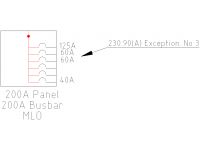An existing Main lug Only service panelboard (MLO) has 4 main breakers installed (service disconnects), and space for two more in the middle.
The existing breakers, installed under 230.90(A) Ex. 3, are 125A, 60A, 60A and a 40A at the bottom.
Presumably the calculated load is 200A.
Looking at the 2023 NEC 705.11, what is the maximum amount of PV that can be connected to this panel?
And does it matter where the breakers are located in the panel?
The existing breakers, installed under 230.90(A) Ex. 3, are 125A, 60A, 60A and a 40A at the bottom.
Presumably the calculated load is 200A.
Looking at the 2023 NEC 705.11, what is the maximum amount of PV that can be connected to this panel?
And does it matter where the breakers are located in the panel?


